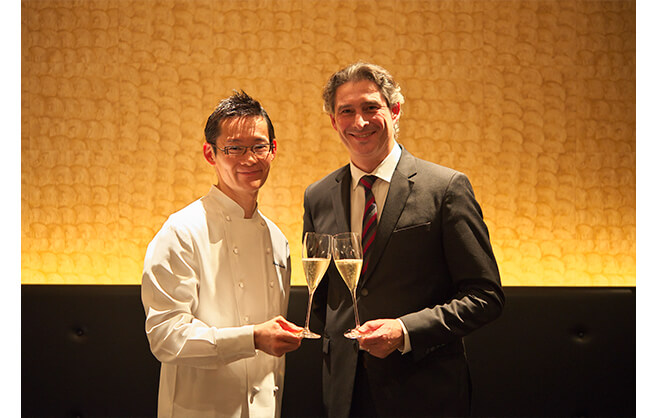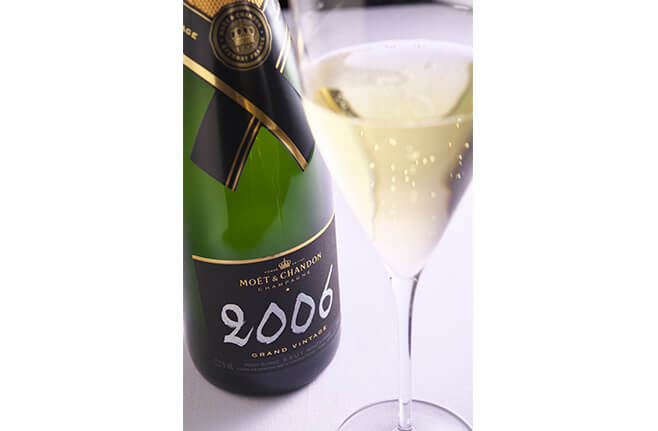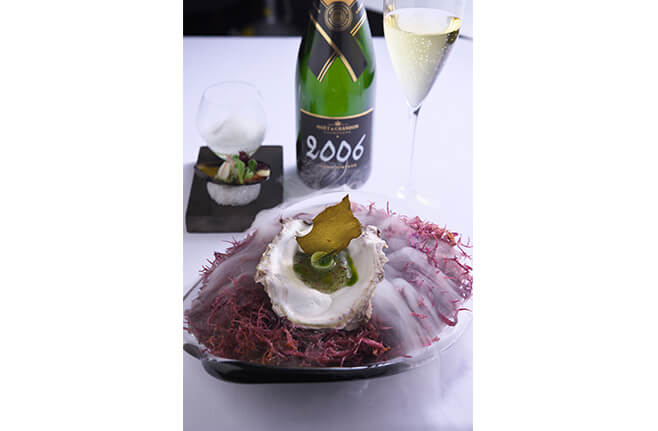GRAND VINTAGE 2006 × LE&(ル・アンド)Vol.2
Fine craftsmanship for cuisine and wine
1999.01.01

After Chef Hajime Yoneda’s visit to “Moët & Chandon” at Epernay in the Champagne region of France, Benoît Gouez in turn visited Osaka to enjoy the marvelous union between the “Grand Vintage 2006” and cuisine of this fine chef.(From left , Hajime Yoneda and Benoît Gouez)
Hajime Yoneda (Hajime): What came to mind during my visit to Epernay was that the sense of “time” in the Champagne region was as I had expected. We chefs always aim for new heights through endeavoring to constantly reform and improve our cooking on a daily basis. However, this same concept cannot be applied to wine, as you are able to have only one chance a year and see the result several years later at the earliest. So you may need to adopt a more long-term perspective and a certain amount of patience.
Benoît Gouez (Benoît): Yes, we have to wait for years to see the fruits of our labor. But this is also a beautiful and fascinating point in the process of winemaking.
Hajime: I agree completely.
Benoît: We accept nature, as it’s impossible to go against nature and time. To make wine after gaining an acceptance of nature...that is our mission. In 2003, I became clearly convinced of this principle. That summer was brutally hot and the grape quality was unfit for traditional champagne. Many houses were forced to give up making the vintage one. But I thought on how to make the best of this situation and decided to modify the method of creating a vintage champagne based upon the grapes. As a result, I was able to achieve a splendid outcome. This experience also changed my approach to vintages from the point of view of just expressing the character of the year to creating a new narrative with the flexibility to accommodate factors that differ due to the circumstances of the moment. In my opinion, fine craftsmanship signifies using precise techniques with a degree of flexibility to work together with change. My guess is that Chef Yoneda agrees with me because the state of ingredients for cooking also differs by circumstance.

Hajime: The act of eating has had a significant impact on human evolution and in a certain way, nutrients such as essential amino acids, the palate, recipes and processing methods have helped to evolve the human race. I think this process will continue in certain ways into the future. From this standpoint, I feel that we should cook in a thoughtful manner. Stated simply, cooking means to process ingredients. There are thousands of ways to process ingredients, but it seems that our brains have only two senses: “pleasure” and “displeasure.” We should then be aware that it’s easy to displease eaters when trying an experimental recipe.
Benoît: Oh, yes. I have had that experience.
Hajime: For me, it is not creation as such, as we should always strive to provide the experience of “pleasure.” I believe that “creation” can be achieved only when the gap between the level of new and existing “pleasure” is great.
Benoît: You're absolutely right. We also greatly value “pleasure” and believe that three factors lead to it: an “accessibility” that encourages everyone to drink it, the “spontaneity” that people feel when coming into contact with the champagne, and a “generosity” that allows one to respond to diversity. So what I create is not a champagne for tasting, but for discovering “pleasure” through its enjoyment.

Hajime: At Epernay, I sampled several vintages and was fascinated by their complexity.
Benoît: Yes, complexity is important. But after years of experience making champagne, I recently came to think that the ultimate form of complexity may be simplicity, which is a perfect balance that has been honed to its utmost.
Hajime: I share that view. It’s something like a perfect sphere consisting of various elements, yet appears simple, as there exists no excess. If we create a thing with perfect balance and harmony that only seems attainable by God, then everyone will appreciate it. I think the same can be said of wine.
Benoît: Today I tried your dishes and sensed that they were created after deep contemplation. You illustrated a universe within each dish. In my case, I always create the universe by understanding and restructuring the components: the variety of grape, village and vintage. For cooking, each ingredient or recipe has a reason for existence and its own role, and you blended them to depict the universe… A controlled and exquisite marriage between your cuisine and our champagne achieved a wonderful balance without a trace of excess.

MOËT & CHANDON “GRAND VINTAGE 2006”
“As soon as the bottle is uncorked, you get a whiff of freshness, soon followed by aged aromas, including that of toast. It’s mineral rather than fruity and there is clearly a nuance of lime stone,” said Chef Yoneda. The theme of the dishes, based on minerality, was “iso (rocky shore).” It’s a three-part mighty work mainly composed of a rock oyster, mussel and sea urchin. “The champagne’s nuance of calcareous matter and clean umami resonate within them.”

MOËT & CHANDON “GRAND VINTAGE 2006” × iso
Front dish: Fresh rock oyster with three types of seaweed sauce using a kelp broth and yogurt sauce that goes with the milky taste of oyster poured over. The yogurt sauce is mixed with cardamom, and a dash of ciboulette oil is sprinkled over the whole dish.
Top rear dish: Sea urchin on a puree of broccoli with a shrimp broth sauce poured over, then covered with an anise seed foam.
Bottom rear dish: Mussel with sauce made of bell pepper, chartreuse and framboise vinegar poured over with quinoa and aneth (dill), garnished with a puree of olive, red perilla, pickled scallion, and myoga (Japanese ginger).
photographs by Harry Nakanishi / English translation by Yuko Wada and Sean Gaston
| ||
| ||
GRAND VINTAGE 2006 × LE& ───────────────────────────────────














